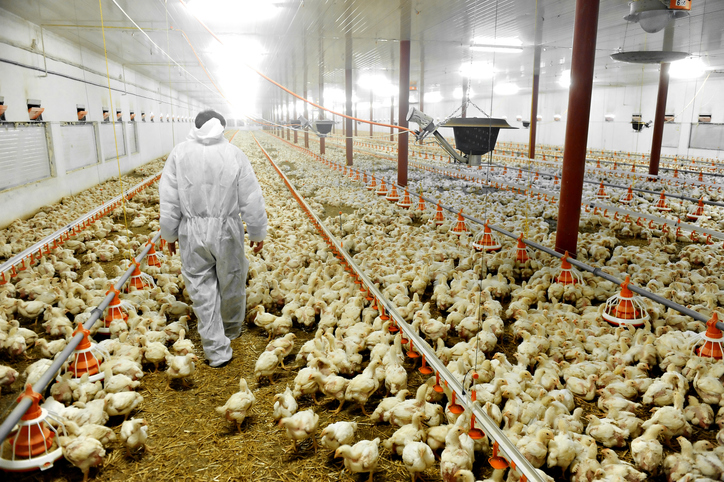Is the Next Pandemic Just a Pig or Poultry Farm Away?

While the supply chain management profession moves toward new territory, the past holds lessons best remembered. Eight billion people worldwide rest their livelihood on that.
Researchers and analysts are sounding the alarm on current farming practices, citing negligent and ignorant behaviors in how animal-based industries gather, hold, process and distribute product. Findings from a Harvard Law School and New York University Center Environmental and Animal Protection joint research project showed the prevalence of risk for another pandemic.
The Cross-Trade
The global economy removed the Earth’s natural boundaries that once made distribution and transportation of animal products prohibitive. Now, multi-continent supply chains can not only move product faster — but if a pathogen exists, its migration from wild animal to livestock to human is much easier.
In a USA Today interview, a lead author of the report, Ann Linder, said increased exposures make the population “more vulnerable than ever.” Her concerns focused on the 200 million live wild animals that the U.S. imports each year, without the normally stringent health or safety requirements that come with food-designated product.
Linder, Harvard Law School Brooks McCormick Jr. Animal Law & Policy Program associate director of policy and research, stated that although West African bush meat that was blamed for the 2013-16 Ebola outbreak, legal importing of the live animals that bush meat originates from continues.
Zoonotic Vulnerabilities
Pig and poultry farms, as well as animals farmed for the fur trade, could cause increased risks for life-altering occurrences of disease, the findings indicated.
Each year, 200 million new land animals are raised in the U.S., adding to the population of 10 billion. The nation is a global leader in pig and poultry breeding, setting an environment for potentially dangerous anomalies of swine and avian flu outbreaks, researchers stated.
Commercial farms can harbor precursors to illness through (1) wild animal imports with minimal to no health assessments, (2) fur trade with minimal oversight and (3) livestocks’ consistent close contact with other animals, handlers and workers.
Governance Gaps
Regulations created and the safeguards they intend to provide can fall short, due to lack of resources and subsequent enforcement. The U.S. Department of Agriculture (USDA) Animal and Plant Health Inspection Service (APHIS) was formulated to protect the country’s agriculture and natural resources against invasive disease. To that end, APHIS is responsible for preventing animal disease infiltrating the nation’s food supply, and regular inspections are one of many protective measures.
USDA’s Food Safety and Inspection Service (FSIS) governs and imposes regulations toward mitigating risks associated with food-borne illness before and after slaughters: the facilities, the animals and meat products. The agency’s processes help ensure quality and safety while identifying initial characteristics and evidence of salmonella, listeria, E. coli, bovine spongiform encephalopathy (BSE, or mad cow disease) and more.
Proponents of greater government oversight called foul on current regulations. Delcianna Winders, associate professor of law, director of the Animal Law and Policy Institute at Vermont Law and Graduate School provided commentary to the Harvard research report; regulations of slaughterhouse and on-farm raising of animals is “extremely inadequate,” she said. She further noted that lax practices mirror deregulation, increasing the risks to animal-based companies and their employees, distributors and consumers — making the supplier to consumer pledge “from farm to table” an unsafe proposition.
Top Diseases on Watchlist
Zoonotic diseases remain of primary concern to international health and safety agencies, including the World Health Organization (WHO). A 2023 National Institute of Public Health (NIH) published work, authored by molecular virologist Gabriele Neumann and virologist Yoshihiro Kawaoka, focused on why the greatest public health risks from zoonotic diseases lie in their epidemic potential and the ineffective countermeasures available.
The WHO cited COVID-19, the Crimean-Congo hemorrhagic fever, Ebola virus disease, Marburg virus disease, Lassa fever, SARS, middle east respiratory syndrome (MERS), Nipah and henipaviral disease, Rift Valley fever, Zika and “Disease X” — a currently unknown pathogen — on its health risk watchlist.
NIH researchers stated recent decade over decade increases in wildlife encroachment and human-to-animal contact, wildlife trade and animal farming as the sources of rising zoonotic risks and propensity for actual events. An in-depth accounting of viral disease by The Washington Post stated that the hub of risk rests in our wildlife, the accessibility of migration to other animal species and humans with no associated immune response available.
Reaching Readiness
WHO director general Tedros Adhanom Ghebreyesus told United Nations member states at the 76th World Health Assembly in May, “The threat of another variant emerging that causes new surges of disease and death remains, and the threat of another pathogen emerging with even deadlier potential remains.”
Albeit the risks of another global pandemic coming to fruition, a systemic mission has been put into place through various initiatives supported by public and private entities to bolster human resiliency against virus-causal destruction.
Increasing health regulations and multi-national agreements designed to abate future emergencies are part of a global cooperative. The Virome Project focuses on the discovery of zoonotic viral threats before they become pandemics. A Berlin-based WHO Pandemic and Epidemic Intelligence hub exists to quickly bring data, analytic tools and predictive models to identify and assess potential threats. The World Bank, the U.S. government and others have funded pandemic-focused prevention, response and treatment programs.
In testimony to the U.S. Senate committee on health, education, labor, and pensions, Dr. Robert M. Califf, FDA commissioner of food and drugs Department of Health and Human Services (DHS) said, “It is critical for the U.S. government to have visibility into the end-to-end supply chain data access.”
As a result, and a matter of future preparedness, U.S. authorities, Califf said, “enhanced FDA’s visibility into drug and medical product supply chains and the tools available to the agency to help identify, prevent, and mitigate drug shortages.”
Collectively, will the above actions be enough to avert the next global pandemic? As with other unexpected disruptions, we may not know until we get there.


